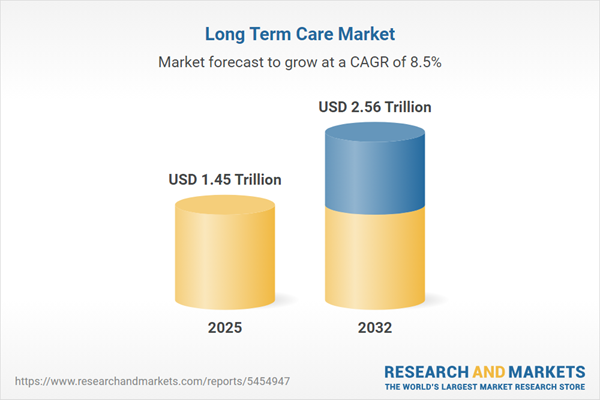Speak directly to the analyst to clarify any post sales queries you may have.
The long term care market is undergoing substantial change, driven by evolving demographics, expanded service offerings, and a rapid increase in digital health adoption. Senior decision-makers must combine innovation with operational strength to stay competitive in a shifting regulatory and patient care environment, prioritizing both resilience and growth.
Market Snapshot: Long Term Care Market Size and Growth
The global long term care market stands at USD 1.33 trillion and is expected to reach USD 1.45 trillion within the next year. Analysts project a compound annual growth rate (CAGR) of 8.49% through 2032, with market value culminating near USD 2.56 trillion. This expansion is fueled by aging populations, growth in chronic conditions, and providers’ investments in IT modernization and enhanced supply chain systems. Executives are also focusing on payer relationships and care delivery efficiency to ensure market adaptability in the face of regulatory and systemic shifts.
Scope & Segmentation in the Long Term Care Market
- Service Types: Includes Assisted Living, Home Care, Home Healthcare, Telehealth, Hospice Care, Memory Care, Home Medical Equipment, and Skilled Nursing, ensuring providers can address diverse and individual patient needs with tailored solutions.
- Care Settings: Covers Adult Day Care, Senior Centers, Nursing Homes, Assisted Living facilities, and at-home delivery supported by Telehealth, reflecting multiple environments that increase access and enable a seamless continuum of care.
- Payer Types: Involves Medicaid, Medicare, Private Insurance, and Out-of-Pocket models which influence cash flow, partnership models, and capital investments for operators internationally.
- End User Segments: Focuses on individuals with Alzheimer’s or dementia, people with disabilities, those managing chronic illnesses, and patients needing rehabilitation, assisting organizations in meeting the full spectrum of long term care complexities.
- Regions Covered: Includes Americas, Europe, Middle East and Africa, and Asia-Pacific; regional approaches are influenced by local regulation, reimbursement processes, and cultural preferences, affecting both strategy and patient engagement.
- Technologies and Approaches: Encompasses Telehealth, digital monitoring, electronic care coordination, and digital therapeutics; these tools streamline workflows, enhance patient involvement, and strengthen care tracking across networks.
- Leading Companies Profiled: Genesis Healthcare, Brookdale Senior Living, Ventas, Welltower, Omega Healthcare Investors, Five Star Senior Living, Capital Senior Living Corporation, Sabra Health Care REIT, National Health Investors, and LTC Properties are highlighted for their innovations and influence within the sector.
Key Takeaways for Senior Leadership
- Drive organizational agility by adopting flexible operations adaptable to demographic and care model evolution.
- Advance digital transformation with expanded use of remote care and integrated collaboration tools for better support of dispersed patient populations.
- Explore mergers, acquisitions, and partnerships that expand service portfolios and improve integration across operational lines.
- Engage proactively with payer organizations to align on value-based models and ensure sustainable operations amid policy shifts.
- Prioritize regulatory awareness and compliance across all operating regions to uphold consistent standards in diverse markets.
- Focus on patient- and family-centered care to boost satisfaction, reinforce trust, and distinguish services in a competitive setting.
Tariff Impact on Long Term Care Supply Chains and Financing
Recent tariff changes in the United States have complicated sourcing medical equipment, introducing new financial and operational risks throughout long term care supply chains. Organizations are adopting collaborative procurement approaches and updating reimbursement strategies to counteract these pressures. Multinational companies are reinforcing local supply chains and instituting robust risk management to maintain continuity during regulatory fluctuations.
Methodology & Data Sources
This report provides insights based on comprehensive secondary research and direct interviews with providers, payers, technology experts, and advocates. Senior industry analysts have reviewed the findings to deliver actionable recommendations and relevant intelligence for leadership strategy.
Why This Long Term Care Market Report Matters
- Equips senior leaders with data-driven guidance to inform strategic planning in a complex market climate shaped by new regulations and shifting care models.
- Delivers segment-specific risk insights while surfacing emerging opportunities through in-depth market segmentation and validated research findings.
- Supports executive decision-making on capital, compliance, and partnership strategies by highlighting evolving industry demands globally.
Conclusion
Embracing new technologies and staying ahead of regulatory changes help long term care providers create stable, future-ready operations. Innovation and strong strategic collaboration ensure organizations remain prepared for ongoing market evolution.
Additional Product Information:
- Purchase of this report includes 1 year online access with quarterly updates.
- This report can be updated on request. Please contact our Customer Experience team using the Ask a Question widget on our website.
Table of Contents
3. Executive Summary
4. Market Overview
7. Cumulative Impact of Artificial Intelligence 2025
Companies Mentioned
The companies profiled in this Long Term Care market report include:- Genesis Healthcare, Inc.
- Brookdale Senior Living, Inc.
- Ventas, Inc.
- Welltower Inc.
- Omega Healthcare Investors, Inc.
- Five Star Senior Living, Inc.
- Capital Senior Living Corporation
- Sabra Health Care REIT, Inc.
- National Health Investors, Inc.
- LTC Properties, Inc.
Table Information
| Report Attribute | Details |
|---|---|
| No. of Pages | 195 |
| Published | October 2025 |
| Forecast Period | 2025 - 2032 |
| Estimated Market Value ( USD | $ 1.45 Trillion |
| Forecasted Market Value ( USD | $ 2.56 Trillion |
| Compound Annual Growth Rate | 8.4% |
| Regions Covered | Global |
| No. of Companies Mentioned | 11 |









